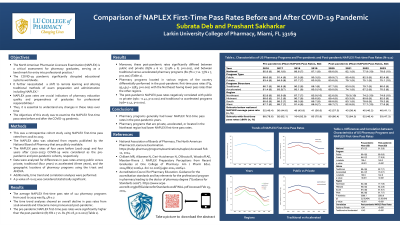Pharmaceutics
(285) Comparison of NAPLEX First-Time Pass Rates Before and After COVID-19 Pandemic


Subrata Deb, B.Pharm., M.Pharm., PhD (he/him/his)
Professor and Chair
Larkin University
Miami, Florida, United States- PS
Prashant Sakharkar, PharmD, MPH
Associate Professor
Larkin University, United States
Primary Author(s)
Co-Author(s)
Objective : To examine the North American Pharmacist Licensure Examination (NAPLEX) first-time pass rates before and after the COVID-19 pandemic.
Methods: This was a retrospective cohort study with NAPLEX first-time pass rates from 2016 to 2023. The NAPLEX pass rates of four years before (2016-2019) and four years after (2020-2023) COVID-19 were considered as the pre-pandemic and post-pandemic cohorts, respectively. Data were analyzed for differences in pass rates among public versus private, traditional (four years) vs accelerated (three years), and the geographic locations of pharmacy programs using the t-test and ANOVA. Additionally, time trend and correlation analyses were performed. A p-value of < 0.05 was considered statistically significant.
Results: The average NAPLEX first-time pass rate of 127 pharmacy programs from 2016 to 2023 was 84.7%+/-7. The time trend analyses showed an overall decline in pass rates from 2016 onwards and it became more pronounced post-pandemic. The pre-pandemic NAPLEX first-time pass rates were significantly higher than the post-pandemic (87.9%+/-7 vs. 81.5%+/-8, p< 0.001). Moreover, these post-pandemic rates significantly differed between public and private (85.2%+/-7 vs. 77.9%+/-8, p< 0.001), and between traditional versus accelerated pharmacy programs (82.7%+/-7.5 vs. 73%+/-7, p< 0.001). Pharmacy programs located in various regions of the country differentially performed in the first-time pass rates (F(3, 103,850) = 2737, p< 0.001) with the Northeast having lower pass rates than the other regions. The post-pandemic NAPLEX pass rates negatively correlated with public vs private (rpb= -0.36 (124), p< 0.0001) and traditional vs accelerated programs (rpb= -0.28 (124), p< 0.0001).
Conclusions: Pharmacy programs generally had lower NAPLEX first-time pass rates in the post-pandemic years. Pharmacy programs that are private, accelerated, and located in the Northeast region had lower NAPLEX first-time pass rates.
Methods: This was a retrospective cohort study with NAPLEX first-time pass rates from 2016 to 2023. The NAPLEX pass rates of four years before (2016-2019) and four years after (2020-2023) COVID-19 were considered as the pre-pandemic and post-pandemic cohorts, respectively. Data were analyzed for differences in pass rates among public versus private, traditional (four years) vs accelerated (three years), and the geographic locations of pharmacy programs using the t-test and ANOVA. Additionally, time trend and correlation analyses were performed. A p-value of < 0.05 was considered statistically significant.
Results: The average NAPLEX first-time pass rate of 127 pharmacy programs from 2016 to 2023 was 84.7%+/-7. The time trend analyses showed an overall decline in pass rates from 2016 onwards and it became more pronounced post-pandemic. The pre-pandemic NAPLEX first-time pass rates were significantly higher than the post-pandemic (87.9%+/-7 vs. 81.5%+/-8, p< 0.001). Moreover, these post-pandemic rates significantly differed between public and private (85.2%+/-7 vs. 77.9%+/-8, p< 0.001), and between traditional versus accelerated pharmacy programs (82.7%+/-7.5 vs. 73%+/-7, p< 0.001). Pharmacy programs located in various regions of the country differentially performed in the first-time pass rates (F(3, 103,850) = 2737, p< 0.001) with the Northeast having lower pass rates than the other regions. The post-pandemic NAPLEX pass rates negatively correlated with public vs private (rpb= -0.36 (124), p< 0.0001) and traditional vs accelerated programs (rpb= -0.28 (124), p< 0.0001).
Conclusions: Pharmacy programs generally had lower NAPLEX first-time pass rates in the post-pandemic years. Pharmacy programs that are private, accelerated, and located in the Northeast region had lower NAPLEX first-time pass rates.

.png)